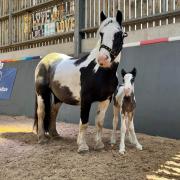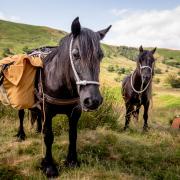Lancashire Life quizzes Kate Long, who grew up in a terrace in Blackrod and became a best-selling novelist. Now an eagerly-awaited sequel is in the shops
Kate Long’s early life would make a novel in itself but it was her Lancashire childhood that formed the framework for her first book which was adapted for television.
Tell us a little about your early life
I was born in London, in a Church of England Children’s Society mother and baby home, in 1964. My parents adopted me at six weeks, on the day of Sir Winston Churchill’s funeral, and Dad still talks about the giant cranes along the Thames dipping respectfully as the funeral barge went past.
I was taken back to Blackrod in Lancashire, a pit village between Wigan and Bolton, and grew up in a red brick terrace with a startling view of Rivington Pike. Growing up as an only child, I had quite a lot of freedom - we were pretty much left to our devices. When I didn’t have my nose in a book I’d be out walking the fields. I didn’t have many friends – I was a bit of an odd child, to be truthful – but I was never lonely or bored.
Did you have an interest in writing from an early age?
Those hours spent on my own helped develop my story-telling brain. I do love a good tale. I was always an avid reader, often reaching for books that were beyond my years. Mum encouraged me and we would read aloud to each other most nights; even when I got to be a teenager we’d have a book on the go.
I realise now that was an extraordinary achievement on her part, because I wasn’t an easy adolescent and very prickly a lot of the time. But we’d come together at the end of each day with a book.
My teachers, too, were hugely inspiring. I still remember the light-bulb moment when we read Ted Hughes’ The Thought-Fox and I said to myself: ‘Wow, English is brilliant!’ The year I turned 12 I was shortlisted in a national creative writing competition but probably the most encouraging comment was from my teacher at 16 who told me: ‘You must write more, and begin keeping a collection of your work.’ It was the first time I felt someone was taking me seriously as an author.
What did you do from after college?
After studying English Literature at Bristol University, where I gained a First, I trained as a primary school teacher, a job I loved. I often made up stories for the children and even wrote hand-made books for them. A few years later, I wanted to teach English and moved into secondary education. I suppose I was hoping to inspire a few ‘light-bulb moments’ of my own!
What inspired your first book?
I decided to write The Bad Mother’s Handbook because I felt no one was really writing about the struggle of ordinary women – lower middle/working class mothers who might have to hold down a job and run a household single-handed.
There were plenty of books on the market about London mums who had fabulous careers and nannies, but I wanted to create a world where the clothes labels were C&A or Topshop rather than Issey Miyake and Ghost. I didn’t actually set out to make it northern, though. The characters themselves announced it, speaking with Bolton accents. So my home ground of Blackrod became the novel’s ‘Bank Top’.
The story itself follows the lives of three members of the same family, a grandmother who is in her late 70s, a 30-something mother and a teenage daughter, and the story reveals what happens to them during the course of a year.
Is the bad mother you, your mother or a complete work of fiction?
Characters have to be flawed or they’re boring. No, chaotic Karen’s not me, not in any sense, and her teenage daughter Charlotte’s a lot cooler than I ever was. That said, some of the stories Nan tells about the past – using Lancashire dialect – are ones my grandma told me, so there is something of her in Nan. They were tales of old Blackrod that I didn’t want to disappear.
Was it difficult to get published?
I wrote for ten years, winning the odd competition but not making much headway with my novel. Then I signed up for an Arvon residential course and had a week working with two professional authors. Their response to what I’d produced was very positive and gave me the impetus to finish The Bad Mother’s Handbook. After that, things happened quickly. I bagged a top agent, had four offers and signed a contract with Picador just before Christmas 2002. The novel was their lead fiction title for 2004, was serialised on Radio 4’s Book at Bedtime, became a number one bestseller and was nominated for a British Book Award. It’s since been sold to 27 countries and in 2007 it was screened as an ITV drama with Catherine Tate.
I’ll be honest, I had trouble initially keeping up with the novel’s success. I’m quite a shy person. The frequent travelling up and down to London also meant I had to give up my teaching job because my two little boys were still at nursery and at a demanding age, and I just couldn’t fit everything in. But the result was that I was around more for them, which turned out to be a wonderful bonus. The Bad Mother probably gave me space to be a better mother in the end.
Tell us about your new book?
I wrote Bad Mothers United in response to readers’ letters and emails asking what happened next, so there was a weight of expectation which was slightly daunting. In addition the character of Daniel Gale, Charlotte’s boyfriend, was played in the TV film by Robert Pattinson and this had led to Daniel having a fan base all of his own. He has his own Facebook page, I was surprised to learn, and his own Twitter account. I can’t tell you how weird that felt, to see a person I’d invented living his own life away from me.
Do your Lancashire roots play a part in your writing?
I’ve written seven novels and three of them have been based completely in Lancashire (the Bad Mother books and Swallowing Grandma). Then there’s Queen Mum which, though set in Chester, features a family who come from Bolton. I love the Lancashire accent. I can hear it in my head so clearly that the dialogue virtually writes itself.
What was it like seeing your work on adapted for television?
It was fascinating to watch. They shot the outside action in Otley because the funding was coming from Screen Yorkshire – oh, the irony! It was thrilling to meet established stars like Catherine Tate and to hear them speaking lines I’d only ever heard in my own head. Of course we didn’t realise what a star-in-the-making we had among us in R-Patz; Robert Pattinson was only 20. A striking-looking young man, though. I felt very proud to have my story broadcast on a mainstream channel to an audience of millions.
What’s next for Kate Long?
I’m currently 50,000 words into a novel about a family affected by the daughter’s anorexia: that should be finished by November and out in spring 2014. And after that I’d like to write about pushy mothers who invest thousands of pounds trying to make their daughters look like models. The domestic stage remains endlessly fascinating to me. Ideas are always queuing up!
Bad Mothers United has already received many good reviews. One critic said: ‘It’s not about middle class yummy mummies taking their children on playdates – it’s more gritty, real and believable as it explores what it’s really like to be a mum.’ Bad Mothers United by Kate Long is published Simon & Schuster, Price £7.99



























